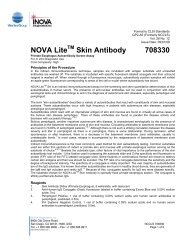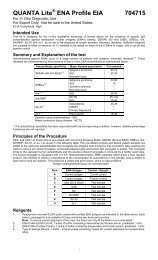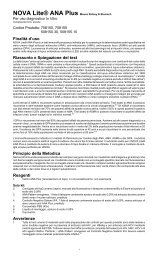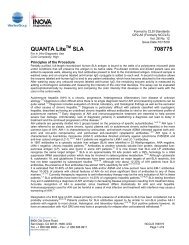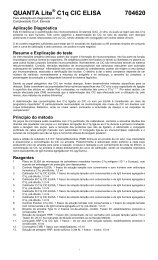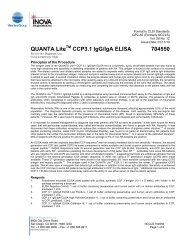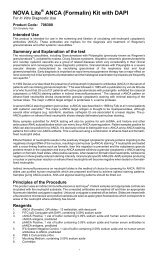INSTRUCTIONS FOR USE BINDAZYME Human ... - inova
INSTRUCTIONS FOR USE BINDAZYME Human ... - inova
INSTRUCTIONS FOR USE BINDAZYME Human ... - inova
Create successful ePaper yourself
Turn your PDF publications into a flip-book with our unique Google optimized e-Paper software.
7 ASSAY METHOD7.1 PRE-ASSAY STEPS1. Bring the kit to room temperature• The kit is designed for room temperature operation (20-24°C).• Remove the kit from storage and stand at room temperature for approximately 60minutes. Wells must not be removed from the foil bag until they have reachedroom temperature.Note: The kits may be maintained at room temperature for up to 1 week.2. Kit componentsGently mix each kit component before use.3. Wash buffer dilutionAdd 50mL of the wash buffer concentrate to 950mL of distilled water (1 in 20dilution) into a clean container and mix. Smaller volumes can be diluted asappropriate.Note: Diluted wash buffer can be stored at room temperature for up to 4 weeks,therefore only dilute the appropriate amount.4. Sample dilutionDilute 10µL of each sample with 1000µL of sample diluent (1:100) and mix well.Note: Diluted sample must be used within 8 hours.5. Strip and frame handlingPlace the required number of wells in the strip holder. Position from well A1, fillingcolumns from left to right across the plate. When handling the plate, squeeze thelong edges of the frame to prevent the wells falling out.Note: Return unused wells to the foil bag immediately with the two desiccantpouches and re-seal tightly to minimise exposure to moisture.Take care not to puncture or tear the foil bag, see below.WARNING: Exposure of wells to moisture or contamination by dust or otherparticulate matter will result in antigen degradation, leading to poor assayprecision and potentially false results.7.2 ASSAY METHODMaintain the same dispensing sequence throughout the assay.1. Sample additionDispense 100µL of each calibrator, control and diluted (1:100) sample into theappropriate wells of the plate provided.Note: Samples should be added as quickly as possible to the plate to minimiseassay drift, and the timer started after the addition of the last sample.Incubate at room temperature for 30 minutes.2. WashingThe washing procedure is critical and requires special attention. An improperlywashed plate will give inaccurate results, with poor precision and highbackgrounds.After incubation remove the plate and wash wells 3 times with 250-350µL washbuffer per well. Wash the plate either by using an automatic plate washer ormanually as indicated below. After the final automated wash, invert the plate andtap the wells dry on absorbent paper.Plates can be washed manually as follows:a. Flick out the contents of the plate into a sink.b. Tap the wells dry on absorbent paper.c. Fill each well with 250-350µL of wash buffer using a multichannelpipette.d. Gently shake the plate on a flat surface.e. Repeat a-d twice.f. Repeat a and b.3. Conjugate additionDispense 100µL of conjugate into each well, blot the top of the wells with a tissueto remove any splashes.Note: To avoid contamination, never return excess conjugate to the reagentbottle.Incubate at room temperature for 30 minutes.4. WashingRepeat step 2.5. Substrate (TMB) additionDispense 100µL of TMB substrate into each well, blot the top of the wells with atissue to remove any splashes.Note: To avoid contamination never return excess TMB to the reagent bottle.Incubate at room temperature in the dark for 30 minutes.6. StoppingDispense 100 µL of stop solution into each well. This causes a change in colourfrom blue to yellow.7. Optical density measurementRead the optical density (OD) of each well at 450nm on a microplate reader,within 30 minutes of stopping the reaction.8 RESULTS AND QUALITY CONTROL1. Quality controlIn order for an assay to be valid, all the following criteria must be met:• Calibrators and the positive and negative controls must be included in each run.• The values obtained for all the controls should be in the ranges specified on theQC Certificate.• The curve shape should be similar to the calibration curve, shown on the QCCertificate.If the above criteria are not met, the assay is invalid and the test should berepeated.2. Calculate mean optical densities (For assays run in duplicate only)For each calibrator, control and sample calculate the mean OD of the duplicatereadings. The percentage coefficient of variation (%C.V.) for each duplicate ODshould be less than 15%.3. Plot calibration curveThe calibration curve can be plotted either automatically or manually as follows byplotting the anticardiolipin autoantibody concentration on the log scale against theOD on the linear scale for each calibrator:• Automatic - use appropriately validated software, and the curve fit that best fits thedata.• Manual - using log/linear graph paper, draw a smooth curve through the points(not a straight line or point to point).4. Treatment of anomalous pointsIf any one point does not lie on the curve, it can be removed. If the absence of thispoint means that the curve has a shape dissimilar to that of the sample calibrationcurve, or more than one point appears to be anomalous, then the assay should berepeated.5. Calculation of autoantibody levels in controls and samplesRead the level of the anticardiolipin autoantibody in the controls and dilutedsamples directly from the calibration curve. The control values should fall withinthe range given on the QC Certificate.Note: The calibrator values have been adjusted by a factor of 100 to account for a1:100 sample dilution. No further correction is required.6. Assay calibrationThe assays are calibrated against the Louisville reference LAPL-GM-200. OneGPL unit is defined as the cardiolipin binding activity of 1µg/mL of an affinitypurified IgG anticardiolipin preparation from a standard serum 14 . One MPL unit isdefined as the cardiolipin binding activity of 1µg/mL of an affinity purified IgManticardiolipin preparation from a standard serum 14 .The Louisville reference centre recommends the following positive discriminationcriteria according to the recommendation of the 2 nd International AnticardiolipinWorkshop 14 .Anticardiolipin IgG Anticardiolipin IgMCriteria Range (GPLU/mL) Range (MPL U/mL)High positive >80 >80Medium positive ≥20-80 ≥20-80Low positive ≥10,




